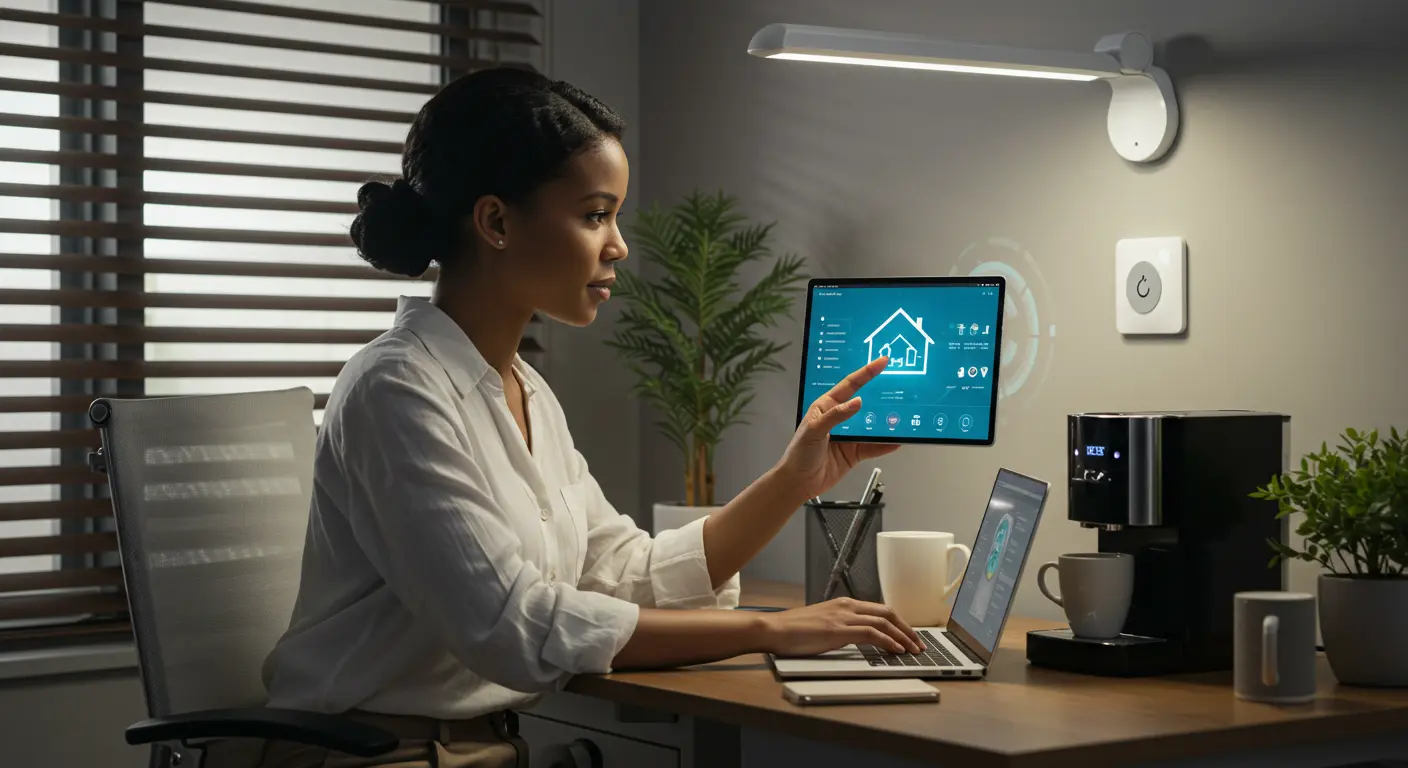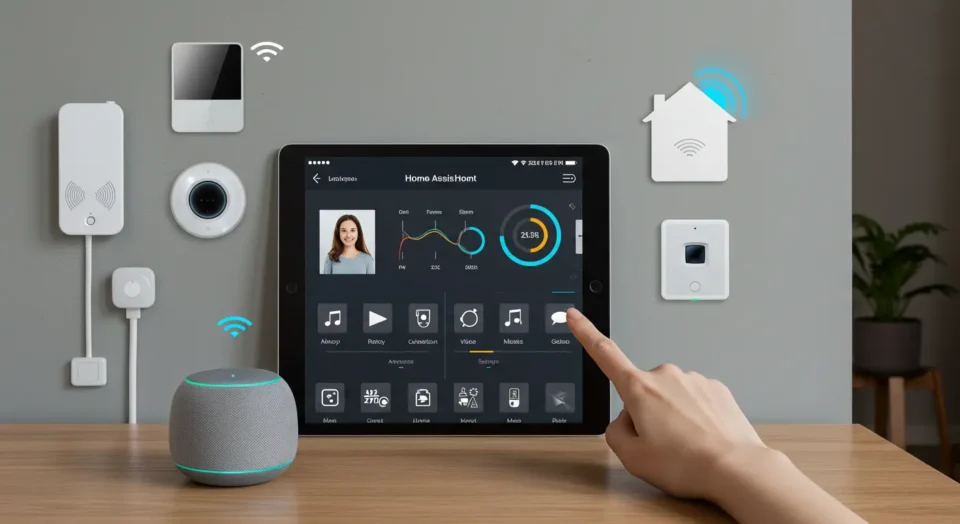Welcome to the exciting world of home automation! Imagine seamlessly controlling your lights, adjusting the thermostat, and even locking your doors – all from the comfort of your couch (or even remotely!).
Home automation makes this dream a reality, transforming your living space into a convenient and efficient haven.
But where do you even begin? Don’t worry, this beginner’s guide will equip you with the essential knowledge to embark on your smart home journey.
What is Home Automation?
Home automation simply means using technology to automate tasks and control various aspects of your home. This can include:
- Lighting: Turn lights on/off remotely, set schedules, and adjust brightness.
- Climate Control: Manage your thermostat for optimal comfort and energy efficiency.
- Security: Lock and unlock doors, receive alerts on suspicious activity, and monitor your home remotely.
- Entertainment: Control your smart TV, speakers, and streaming devices with voice commands or your smartphone.
- Appliances: Schedule your smart washing machine or coffee maker to run when it’s convenient for you.
For Example:
Home automation simplifies daily tasks and enhances convenience by integrating smart technology into your home.
For instance, imagine arriving home after a long day at work. As you approach your front door, it automatically unlocks thanks to a smart lock system connected to your smartphone.
This seamless entry not only saves you the hassle of fumbling for keys but also provides added security by ensuring your door is always locked when you’re away.
Benefits of Home Automation
There are numerous advantages to embracing home automation:
Convenience
Home automation simplifies daily tasks by allowing you to control various aspects of your home remotely. Instead of manually adjusting lights, thermostats, or security systems, you can do so with a few taps on your smartphone or even through voice commands.
This convenience saves time and effort, making your daily routines smoother and more efficient.
Energy Efficiency
Automated systems enable you to optimize energy usage in your home. For example, smart thermostats can learn your heating and cooling preferences and adjust accordingly, leading to energy savings without sacrificing comfort.
Similarly, smart lighting systems can automatically turn off lights in unoccupied rooms, reducing unnecessary energy consumption.
Enhanced Security
Home automation enhances security by providing real-time monitoring and control over your home’s security systems.
With smart door locks, motion sensors, and security cameras, you can receive instant alerts about suspicious activities and take appropriate action, such as remotely locking doors or contacting authorities.
This proactive approach to security helps deter potential intruders and provides peace of mind, especially when you’re away from home.
Customization and Personalization
Home automation allows for customization and personalization according to your preferences and lifestyle.
You can create personalized schedules for lighting, heating, and other systems to align with your daily routines.
Additionally, smart home devices often come with advanced settings and features that can be tailored to suit your specific needs, whether it’s adjusting the color temperature of your smart bulbs or setting up custom scenes for different occasions.
Remote Access and Monitoring
One of the significant advantages of home automation is the ability to monitor and control your home remotely.
Whether you’re at work, traveling, or simply away from home, you can access your smart home devices through mobile apps or web interfaces.
This remote access allows you to check on your home, adjust settings, and receive notifications from anywhere with an internet connection, providing flexibility and peace of mind.
Getting Started with Home Automation
Here’s a roadmap to guide you on your first steps:
Step 1: Define Your Needs
Before diving into the world of home automation, it’s essential to define your needs and priorities. Consider what aspects of your home you want to automate and why.
Are you looking for convenience, security, energy efficiency, or all of the above? Take some time to brainstorm and make a list of your must-have features.
Step 2: Set a Budget
Home automation can be as budget-friendly or as extravagant as you’d like it to be. Start by setting a budget that aligns with your goals and financial resources.
Remember that home automation is scalable, so you can start small with a few key devices or a starter kit and gradually expand your setup over time.
Step 3: Choose Your Smart Home Ecosystem
Once you’ve defined your needs and set a budget, it’s time to choose the right smart home ecosystem for your setup.
Popular options include Google Home, Amazon Alexa, Apple HomeKit, and Samsung SmartThings, among others.
Each platform has its strengths and compatible devices, so do some research to determine which one best suits your preferences and existing technology ecosystem.
Step 4: Start with Essential Devices
Now that you have a clear plan in place, it’s time to start building your smart home setup.
Begin with essential devices that offer immediate convenience without requiring complex installations.
Smart plugs, smart bulbs, and a smart thermostat are excellent choices for beginners.
These devices can be easily integrated into your existing home infrastructure and provide tangible benefits right from the start.
Step 5: Explore Home Assistant
For those seeking deeper customization and control, consider exploring Home Assistant.
This open-source platform offers unparalleled flexibility and advanced features for managing and automating your smart home devices.
While it may require a bit more technical know-how, Home Assistant empowers you to create a truly customized smart home experience tailored to your needs.
Learn and Experiment
Home automation is all about learning and experimentation. Take the time to explore the capabilities of your chosen platform, experiment with different devices and automations, and don’t be afraid to make mistakes along the way. The more you learn, the more you’ll be able to tailor your smart home to suit your lifestyle.
Important Considerations
Compatibility
Before investing in smart home devices, it’s crucial to ensure compatibility with your chosen smart home ecosystem.
Compatibility ensures seamless integration and communication between different devices, allowing them to work together effectively.
For instance, if you have a smart speaker like Amazon Echo or Google Home, you’ll want to ensure that any smart lights, thermostats, or other devices you purchase are compatible with the voice assistant platform you prefer.
This compatibility ensures that you can control all your devices using a single interface, enhancing convenience and efficiency.
Security
Security is paramount when it comes to smart home technology. When selecting smart home devices, prioritize those with robust security features and encryption protocols to safeguard your data and privacy.
Look for devices that offer regular firmware updates and have built-in security measures such as two-factor authentication and encryption of data in transit and at rest.
Additionally, consider using a secure Wi-Fi network with a strong password to protect your smart home devices from unauthorized access.
Installation
Consider the level of technical expertise required for the installation and configuration of your chosen smart home devices.
Some devices may be plug-and-play, requiring minimal setup and technical knowledge, while others may require more complex installation procedures, such as wiring or integration with existing systems.
Assess your own technical skills and comfort level with technology before purchasing devices that may require advanced installation or configuration.
Alternatively, you can enlist the help of professional installers or technicians to ensure that your smart home setup is installed correctly and functions optimally.
The Future of Home Automation
Home automation is constantly evolving, offering exciting possibilities for the future. Imagine seamlessly integrating various smart devices to create a truly connected and responsive living environment.
AI-Powered Automation
As artificial intelligence (AI) continues to advance, home automation systems will become increasingly intelligent and adaptive. AI algorithms will analyze data from various sensors and devices to learn your habits, preferences, and patterns of behavior, allowing for more personalized and predictive automation.
For example: AI-powered systems could anticipate your needs by adjusting lighting, temperature, and other settings based on your daily routines and activities.
IoT Integration
The Internet of Things (IoT) will play a central role in the future of home automation, with a growing number of smart devices and sensors seamlessly interconnected to create a unified ecosystem.
From smart appliances and wearables to connected vehicles and environmental sensors, the IoT will enable comprehensive monitoring and control of various aspects of your home and lifestyle.
This integration will enable greater efficiency, convenience, and customization in managing your smart home.
Enhanced Interactivity
Future home automation systems will offer enhanced interactivity and intuitive control mechanisms, making it easier than ever to interact with your smart home devices.
Natural language processing (NLP) technology will enable more seamless voice control, allowing you to communicate with your smart home system using natural language commands and conversational interactions.
Additionally, advances in gesture recognition and augmented reality (AR) interfaces may provide new ways to interact with and control your smart home devices.
Predictive Maintenance
Home automation systems will incorporate predictive maintenance capabilities to anticipate and prevent potential issues with your home infrastructure and devices.
By analyzing data from sensors and IoT devices, these systems can detect early signs of equipment failure or inefficiency and proactively schedule maintenance or repairs before problems arise.
This predictive approach will help minimize downtime, reduce maintenance costs, and ensure optimal performance and reliability of your smart home systems.
Energy Efficiency and Sustainability
The future of home automation will prioritize energy efficiency and sustainability, with smart systems optimizing energy usage and promoting eco-friendly practices.
Advanced algorithms will continuously monitor and adjust energy consumption based on factors such as occupancy, weather conditions, and energy prices, maximizing efficiency while minimizing environmental impact.
Integration with renewable energy sources, such as solar panels and energy storage systems, will further enhance sustainability and resilience in smart homes.
Ready to Take the Plunge?
The world of home automation is waiting for you! With a clear understanding of its benefits and this beginner’s guide as your roadmap, you can embark on this exciting journey and transform your home into a smart oasis tailored to your needs and preferences.
Remember, start small, prioritize your needs, and explore the vast possibilities that home automation offers.


